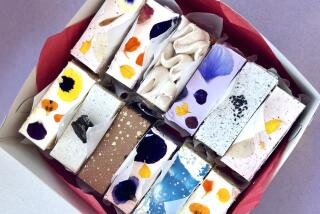It’s a Piece of Cake
- Share via
The conventional method of combining cake ingredients, when properly executed, produces a tender cake with a light, delicate texture.
The ingredients for the recipe should be measured ahead of time and brought to room temperature, particularly the fat and eggs. If the eggs need to be separated, however, it’s easier to do as soon as they’re removed from the refrigerator.
Hydrogenated vegetable shortening, butter, margarine or a combination of these solid fats may be used in cake baking. Shortening produces cakes with a fine texture; butter and margarine contribute flavor and color.
Scrape down the sides of the bowl with a rubber spatula throughout the batter-making process to ensure even mixing. Use medium mixing speed; high speed will warm the ingredients too quickly.
Once prepared, pour the batter into greased and floured pans. As an added precaution against sticking, the pans may be lined with wax paper or cooking parchment.
Temperature, pan placement and timing are all important when baking cakes. Unless you’re certain the oven you’re using is calibrated correctly, double check the temperature with a supplementary oven thermometer. A temperature of 375 degrees is typically used when baking shortened cakes.
Place cake pans on the center rack in a preheated oven. They should not touch each other, and there should be at least 1 inch between the pans and oven walls to allow for even heat circulation.
In very small ovens, it may be necessary to place the pans on two racks. These racks should be placed in the middle third of the oven with enough space between for the cake on the lower rack to rise. In this configuration, the pans may need to be turned a few times to promote even baking. Position the cake pans so they are not directly over each other.
Begin testing for doneness five minutes before the specified baking time has elapsed, or when the lower time of a baking range (such as 25 to 30 minutes) has been reached. There are two tests for doneness:
Insert a toothpick into the center of the cake. If it comes out clean and dry--with no batter or crumbs clinging to it--the cake is done.
You may also lightly touch the top of the cake with your finger. If properly baked, the cake should spring back, leaving no imprint.
Once they’re done, remove cakes from the oven and cool in the pans on wire racks that allow air to circulate underneath. Cakes are ready to be removed from the pans when the bottoms feel just warm to the touch.
LUSCIOUS CHOCOLATE CAKE
4 (1-ounce) squares unsweetened chocolate
1/2 cup hot water
1 3/4 cups sugar
1/2 cup butter
1/4 cup shortening
4 eggs
1 teaspoon vanilla extract
2 cups sifted cake flour
1 teaspoon baking soda
1 teaspoon salt
3/4 cup milk
Combine chocolate and hot water in top of double boiler. Cook, stirring, over simmering water until chocolate melts and mixture thickens. Add 1/2 cup sugar and cook, stirring, 2 minutes. Cool.
Cream butter and shortening by beating until smooth and creamy. Continue beating while gradually adding remaining 1 1/4 cups sugar until mixture is fluffy. Add eggs, 1 at time, beating well after each addition. Blend in melted chocolate and vanilla.
Re-sift flour with baking soda and salt. Add alternately with milk to batter.
Pour batter into 2 (9-inch) round cake pans, which have been greased, floured and lined with waxed paper or parchment. Bake at 350 degrees 30 to 35 minutes or until toothpick inserted near centers comes out clean.
Cool cakes 10 minutes before removing from pans, then cool completely on wire racks.
Makes 1 double-layer (9-inch) cake, about 8 servings.
Each serving contains about:
446 calories; 341 mg sodium; 108 mg cholesterol; 17 grams fat; 70 grams carbohydrates; 8 grams protein; 0.41 gram fiber.


